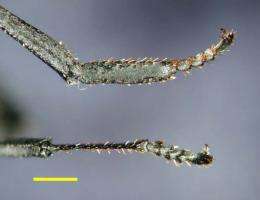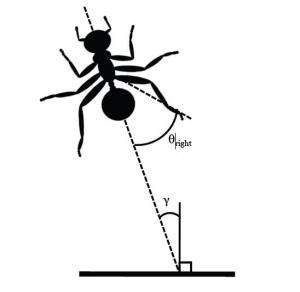March 18, 2010 report
Wingless ants glide to safety steering with their hind legs (w/ Video)

(PhysOrg.com) -- The tree-dwelling tropical ants Cephalotes atratus build their nests in tall trees, but launch themselves into the air when threatened by predators. Scientists studying these wingless ants have discovered they use their rear legs as rudders to guide them back to the tree.
The arboreal ants jump from the safety of the tree if threatened by birds or lizards, and they sometimes fall from the tree in windy conditions or in tropical storms. Researchers working at the US Smithsonian Tropical Research Institute on Barro Colorado Island in the Panama canal have found the ants glide back to the tree by flipping in mid-air and gliding backwards, seeing where they are going by looking between their legs, and steering using their unusually long hind legs. The elongated rear legs of the centimeter-long ants also help them latch onto the tree when landing.
The scientists studied the ants by collecting some ants and painting them with white nail polish to make them easier to spot. They plucked one or two legs off some of the ants, then climbed to the top of the trees and dropped the ants from the treetops and videoed their fall. They then verified their findings in the laboratory, where they used a high-speed video camera.
The results showed the ants could still glide back to the tree even if both rear legs were removed, but they were not able to steer as well. Intact ants were able to land on a tree trunk over 90 percent of the time; ants with the mid legs removed succeeded less than 70 percent of the time, but in those with hind legs removed the success rate was reduced to about 40 percent.

Leader of the research team, Stephan Yanoviak of the University of Arkansas at Little Rock, said it was important for the ants to avoid falling to the leaf litter on the ground or into water because they would most likely be eaten. Their gliding abilities allow them to steer back to the tree (usually the tree they fell from), and then climb back up to the safety of the nests built into the branches and trunk at the top of the trees.
The study also learned that if the ants are attacked by predators they release an alarm pheromone that warns nearby ants to jump off the tree to safety.
Yanoviak said studying the ant’s control of its fall is relevant to understanding the behavior, and also the flight of insects generally. The study is published in the journal Proceedings of the Royal Society B.
More information: Aerial manoeuvrability in wingless gliding ants (Cephalotes atratus), Proceedings of the Royal Society B, Published online before print March 17, 2010, doi:10.1098/rspb.2010.0170
© 2010 PhysOrg.com

















